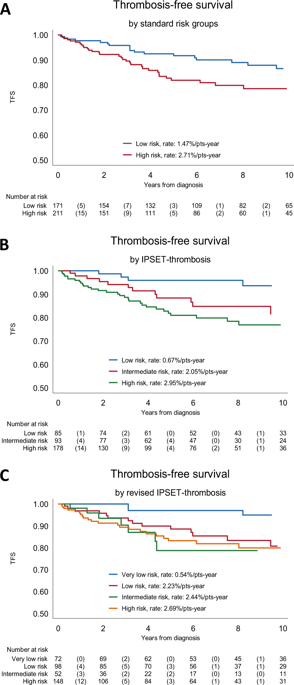当前位置:
X-MOL 学术
›
Blood Cancer J.
›
论文详情
Our official English website, www.x-mol.net, welcomes your
feedback! (Note: you will need to create a separate account there.)
Validation of the IPSET score for thrombosis in patients with prefibrotic myelofibrosis.
Blood Cancer Journal ( IF 12.9 ) Pub Date : 2020-02-25 , DOI: 10.1038/s41408-020-0289-2 Paola Guglielmelli 1 , Alessandra Carobbio 2 , Elisa Rumi 3 , Valerio De Stefano 4 , Lara Mannelli 1 , Francesco Mannelli 1 , Giada Rotunno 1 , Giacomo Coltro 1 , Silvia Betti 4 , Chiara Cavalloni 3 , Maria Chiara Finazzi 5 , Juergen Thiele 6 , Mario Cazzola 3 , Alessandro Maria Vannucchi 1 , Tiziano Barbui 2
Blood Cancer Journal ( IF 12.9 ) Pub Date : 2020-02-25 , DOI: 10.1038/s41408-020-0289-2 Paola Guglielmelli 1 , Alessandra Carobbio 2 , Elisa Rumi 3 , Valerio De Stefano 4 , Lara Mannelli 1 , Francesco Mannelli 1 , Giada Rotunno 1 , Giacomo Coltro 1 , Silvia Betti 4 , Chiara Cavalloni 3 , Maria Chiara Finazzi 5 , Juergen Thiele 6 , Mario Cazzola 3 , Alessandro Maria Vannucchi 1 , Tiziano Barbui 2
Affiliation

|
Pre-fibrotic myelofibrosis (pre-PMF) and essential thrombocythemia (ET) are characterized by similarly increased rate of thrombotic events, but no study specifically analyzed risk factors for thrombosis in pre-PMF. In a multicenter cohort of 382 pre-PMF patients collected in this study, the rate of arterial and venous thrombosis after diagnosis was 1.0 and 0.95% patients/year. Factors significantly associated with arterial thrombosis were age, leukocytosis, generic cardiovascular risk factors, JAK2V617F and high molecular risk mutations, while only history of previous thrombosis, particularly prior venous thrombosis, was predictive of venous events. The risk of total thromboses was accurately predicted by the the international prognostic score for thrombosis in essential thrombocythemia (IPSET) score, originally developed for ET, and corresponded to 0.67, 2.05, and 2.95% patients/year in the low-, intermediate-, and high-risk categories. IPSET was superior to both the conventional 2-tiered score and the revised IPSET in this cohort of pre-PMF patients. We conclude that IPSET score can be conveniently used for thrombosis risk stratification in patients with pre-PMF and might represent the basis for individualized management aimed at reducing the increased risk of major cardiovascular events. Further refinement of the IPSET score in pre-PMF might be pursued by additional, prospective studies evaluating the inclusion of leukocytosis and/or adverse mutational profile as novel variables.
中文翻译:

纤维化前骨髓纤维化患者血栓形成IPSET评分的验证。
纤维化前的骨髓纤维化(pre-PMF)和原发性血小板增多症(ET)的特征是血栓事件的发生率相似地增加,但是尚无研究专门分析PMF之前血栓形成的危险因素。在这项研究收集的382名PMF前患者的多中心队列中,诊断后的动脉和静脉血栓形成率分别为1.0和0.95%患者/年。与动脉血栓形成显着相关的因素是年龄,白细胞增多,通用的心血管危险因素,JAK2V617F和高分子风险突变,而只有先前血栓形成的历史,尤其是先前的静脉血栓形成,才可以预测静脉事件。血栓形成的国际预后评分是由原发于ET的国际血栓预后评分(IPSET)准确预测的,在低,中和高风险类别中,分别对应于0.67、2.05和2.95%的患者/年。在该PMF前期患者队列中,IPSET优于传统的2级评分和修订的IPSET。我们得出的结论是,IPSET评分可方便地用于PMF前患者的血栓形成风险分层,并且可能代表了旨在降低重大心血管事件风险增加的个体化管理的基础。可以通过其他前瞻性研究评估白细胞增多症和/或不良突变谱是否为新变量来进一步完善PMF前的IPSET评分。在该PMF前期患者队列中,IPSET优于传统的2级评分和修订的IPSET。我们得出的结论是,IPSET评分可方便地用于PMF前患者的血栓形成危险分层,并且可能代表了旨在降低重大心血管事件风险增加的个体化管理的基础。可以通过其他前瞻性研究评估白细胞增多症和/或不良突变谱是否为新变量来进一步完善PMF前的IPSET评分。在该PMF前期患者队列中,IPSET优于传统的2级评分和修订的IPSET。我们得出的结论是,IPSET评分可方便地用于PMF前患者的血栓形成风险分层,并且可能代表了旨在降低重大心血管事件风险增加的个体化管理的基础。可以通过其他前瞻性研究评估白细胞增多症和/或不良突变谱是否为新变量,从而进一步完善PMF前的IPSET评分。
更新日期:2020-02-25
中文翻译:

纤维化前骨髓纤维化患者血栓形成IPSET评分的验证。
纤维化前的骨髓纤维化(pre-PMF)和原发性血小板增多症(ET)的特征是血栓事件的发生率相似地增加,但是尚无研究专门分析PMF之前血栓形成的危险因素。在这项研究收集的382名PMF前患者的多中心队列中,诊断后的动脉和静脉血栓形成率分别为1.0和0.95%患者/年。与动脉血栓形成显着相关的因素是年龄,白细胞增多,通用的心血管危险因素,JAK2V617F和高分子风险突变,而只有先前血栓形成的历史,尤其是先前的静脉血栓形成,才可以预测静脉事件。血栓形成的国际预后评分是由原发于ET的国际血栓预后评分(IPSET)准确预测的,在低,中和高风险类别中,分别对应于0.67、2.05和2.95%的患者/年。在该PMF前期患者队列中,IPSET优于传统的2级评分和修订的IPSET。我们得出的结论是,IPSET评分可方便地用于PMF前患者的血栓形成风险分层,并且可能代表了旨在降低重大心血管事件风险增加的个体化管理的基础。可以通过其他前瞻性研究评估白细胞增多症和/或不良突变谱是否为新变量来进一步完善PMF前的IPSET评分。在该PMF前期患者队列中,IPSET优于传统的2级评分和修订的IPSET。我们得出的结论是,IPSET评分可方便地用于PMF前患者的血栓形成危险分层,并且可能代表了旨在降低重大心血管事件风险增加的个体化管理的基础。可以通过其他前瞻性研究评估白细胞增多症和/或不良突变谱是否为新变量来进一步完善PMF前的IPSET评分。在该PMF前期患者队列中,IPSET优于传统的2级评分和修订的IPSET。我们得出的结论是,IPSET评分可方便地用于PMF前患者的血栓形成风险分层,并且可能代表了旨在降低重大心血管事件风险增加的个体化管理的基础。可以通过其他前瞻性研究评估白细胞增多症和/或不良突变谱是否为新变量,从而进一步完善PMF前的IPSET评分。











































 京公网安备 11010802027423号
京公网安备 11010802027423号